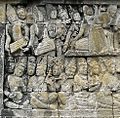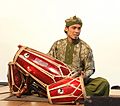Kendang facts for kids
A kendang is a special type of drum with two heads, meaning it has a playing surface on both sides! These drums are super important in Gamelan music, which is a traditional style of music from Maritime Southeast Asia. You'll find different kinds of kendangs made by various ethnic groups across this region, each with its own unique look and sound.
What is a Kendang?
A kendang is a percussion instrument, which means you play it by hitting it. It's a type of drum often shaped like a barrel or a cone. The two drumheads are usually made from animal hide, like buffalo or goat skin. These heads are stretched over the drum's body and held tight with ropes or rattan.
Kendang in Gamelan Music
The kendang is a very important drum in Gamelan music. Gamelan is a traditional orchestra from places like Indonesia and Malaysia. It uses many different instruments, mostly gongs and metallophones (instruments like xylophones but with metal bars). The kendang player is like the conductor of the Gamelan orchestra. They lead the tempo and rhythm for all the other musicians.
Different Kendang Styles
Kendangs come in many shapes and sizes, depending on where they are made and which ethnic group uses them.
- Javanese Kendang: In Java, Indonesia, kendangs often have one side that is bigger than the other. This gives them two different sounds, a lower pitch and a higher pitch.
- Balinese Kendang: In Bali, Indonesia, kendangs often have both sides about the same size. They can also be shaped like an hourglass on the inside.
- Sundanese Kendang: The Sundanese people from West Java also have their own style of kendang, which is crucial for their Gamelan music, like Gamelan degung.
The way a kendang is made and played gives each type its own special voice in the rich world of Gamelan music.
Images for kids
-
Various Kendangs (top row) depicted on the 8th-century of Borobudur temple in Central Java, Indonesia
-
Kendang of Java, one side is bigger than other.





